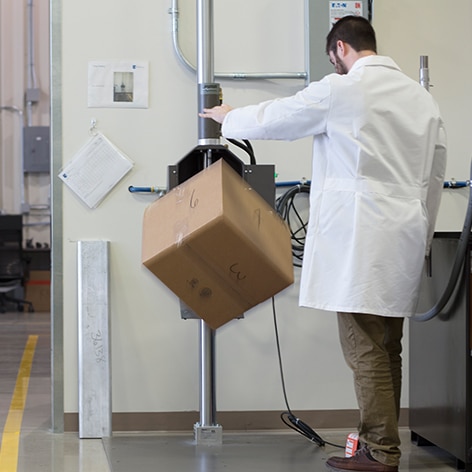

Many clients often ask us why we test the way we do, and our answer is always the same. We abide by the test methods that we have under our scope of ISO 17025. One of the most popular forms of testing we do daily is transit testing, which typically falls under the standard of ASTM D4169. This standard contains a list of other standards that dictate how we complete each portion of the test. One of those methods is ASTM D5276. This is the section that covers drop testing, specifically called the, “Drop Test of Loading Containers by Free Fall.” That’s a mouthful!
So, What is ASTM Drop Testing?
Drop testing is an assessment that scientifically mimics the forces experienced on a package when it is thrown, kicked or tossed around while making it through the shipping environment. For this, think about all those Christmas packages you ordered online that you saw the driver toss on to your front porch like he was a quarterback in the NFL. For us, we take this action and make it a bit more standardized and scientific to account for all the possible ways a box could drop and land.
What was the Previous Method?
Previously when conducting drop testing our lab technicians would look for the manufacturer’s joint on the box. From there they would label the sides, using that as a point of reference for orientation. This labeling and orientation would then dictate from which ways the box was dropped. While the manufacturers joint is a good reference, we found that this does not always serve as the best for that specific client’s packaging orientation. It is for this reason that we welcomed the change!
What’s New?
Now ASTM has revised the standard to allow for more flexibility with added verbiage about ensuring the orientation matches the specific configuration of that shipper. This allows are lab technicians to look at each client’s shipping configuration and base the drop orientations from what best makes sense for their package. The goal is always to optimize stability and by allowing for this customization, our lab can now do just that!
We are always looking for ways to help our customers and provide inputs on how best to get their packages to pass transit testing such as, ASTM D4169. Whether it is an effort of our root cause analysis team to help mitigate failures or our lab technicians providing insights into potential opportunities for failures – we are always keeping fast, passing results in mind. We are fortunate to work in an industry where organizations such as ASTM are looking out for what’s best for the market, like how we are for our clients.